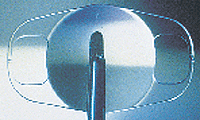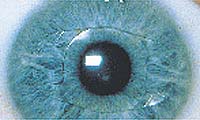Phakic IOLs are still works in progress
Surgeons familiar with their use say the lenses offer several advantages, but there is room for improvement.
Three phakic IOLs currently widely available share advantages and disadvantages, according to surgeons familiar with their use. The ICL (STAAR Surgical AG, Nidau Switzerland), Artisan (Ophtec BV, Groningen, Netherlands) and NuVita (Bausch & Lomb Surgical, Claremont, U.S.A.) phakic IOLs have all undergone multiple design changes since their inception.
Advantages include the fact that all these lenses leave a continuous normal corneal curvature, they potentially offer a full range of optical correction, they can be removed, and laser in situ keratomileusis (LASIK) may be used in addition to their implantation to allow higher levels of correction.
Disadvantages include potential complications, design problems and difficulty in obtaining individualized treatment.
“I would predict in a couple of years that we will not be using any of these three particular designs but that we will have improved designs,” said George O. Waring III, MD, of the Emory Vision Correction Center in Atlanta. “There are many future developments coming in terms of foldable lenses, lenses that can be modified inside of the eye, toric lenses and maybe lenses that could be custom designed.”
Dr. Waring would prefer that future phakic IOLs have larger optics. “The optic diameter is important because of the edge design,” Dr. Waring said. “Clearly, we would like to see a larger diameter and more effective optical zone. I think ideally it should be out to 7 mm, which would put the edge outside of the mesopic pupil in most eyes.”
Dr. Waring predicted that future phakic IOLs will go through smaller incisions, by being foldable and through the use of injectors, in order to conform to modern cataract-style surgery.
ICL
 ---The Artisan Myopia
5-mm Lens is held here by Budo forceps.
---The Artisan Myopia
5-mm Lens is held here by Budo forceps.
The procedure
for implanting the ICL is not complicated, according to Ricardo Q.
Guimarães, MD, PhD, a refractive and cataract surgeon in Belo Horizonte,
Brazil. The procedure entails a small incision comparable with the incision
used in cataract surgery. The ICL is implanted similarly to how a foldable IOL
is inserted in cataract surgery, Dr. Guimarães said. The behavior of the
cartridge and the injector is almost identical. However, when the lens is in
the anterior chamber and placed under the iris, it requires a specific
technique that demands a careful surgeon and surgical procedure to ensure that
the ICL does not hit the crystalline lens. Haptic fixation is in the
sulcus.
Dr. Guimarães and coworkers implanted the ICL in 160 eyes for myopia and hyperopia. The lens also was used after radial keratotomy overcorrection and in eyes with keratoconus.
Early complications were rare and were related to surgical technique, without significant loss of best corrected visual acuity (BCVA). The few early complications included an increase in intraocular pressure, pupillary block and lens opacification. No late complications were observed between 9 and 30 months, and none of the ICLs needed to be removed or exchanged. Successful correction was accomplished with about one-half of the study eyes achieving a significant improvement in BCVA.
In myopic eyes of up to –20 D, the average preoperative spherical equivalent (SE) was 13 D, and the postop SE was 0.92 D. The mean preoperative cylinder was –1.6 D and 1 D postoperatively. Astigmatism was managed by placing the incision at the steepest axis. Predictability is considered in terms of SE, and some patients were left with some astigmatism but not much, he said. According to the study, 60% of the patients were in the range of ±1 D of astigmatism. Most patients gained lines of vision.
Dr. Guimaraes concluded that the ICL for moderate to high myopia is safe, effective and predictable, with high patient satisfaction.
Artisan lens
 ---Scheimpflug
photo of the Artisan Myopia 5-mm Lens shows position of ocular
structures.
---Scheimpflug
photo of the Artisan Myopia 5-mm Lens shows position of ocular
structures.
At 6 months following implantation of the Artisan
lens, 84% of 135 eyes had 20/40 vision or better, and 50% were 20/25 or better,
according to Robert K. Maloney, MD, of Los Angeles. None of the eyes in his
series lost two lines of spectacle corrected acuity at 6 months, and most eyes
had a gain in spectacle corrected visual acuity, presumably due to
magnification.
“For refractive accuracy, we found that 90% of eyes were within 1 D,” Dr. Maloney said. “This is significantly better than you could do with LASIK for 13 D of myopia. Nearly two-thirds of eyes were within 0.5 D with no systematic undercorrection or overcorrection.” At 1 day postop, SE refraction stabilized, according to Dr. Maloney, with virtually no change after that because there was no corneal wound healing.
The Artisan lens is inserted into the eye through a 5-mm or 6-mm incision, depending on the size of the optic. Due to the incision size, there is induced astigmatism in the early postoperative period, which reduces with time as the surgeon adjusts or removes sutures. There was an average of 1 D of astigmatism increase 1 day after surgery, but by 1 month postop, it had declined to its preoperative level or below.
According to Dr. Waring, in terms of ease of sizing, the Artisan is superior to other phakic lenses. The Artisan comes in an optic sized 5 mm or 6 mm and has an 8.5 mm overall diameter in all eyes.
The lens is positioned close to the iris and far from the corneal endothelium, leaving approximately a 3-mm gap between the lens and the endothelium. The lens is fixated in the peripheral iris instead of near the pupil, making it more stable than previous phakic lens designs, with less likelihood of endothelial cell loss. There was no change in endothelial cell count at 6 or 12 months postop.
“I believe that the safety of this lens results from its position far away from vital structures such as the endothelium, the crystalline lens and the anterior chamber angle,” Dr. Maloney said.
Reported adverse events included one lens exchange due to an operating room error in which a lens of the wrong power was inserted. Three lenses with a 5-mm optic were exchanged for a 6-mm optic because the patients complained of halos. One lens was recentered due to improper positioning in the initial surgery. One lens was removed because of patient anxiety about having an investigational device in his eye, and one patient developed aspiration pneumonia from general anesthesia, which later resolved.
NuVita
 ---Fixation points
are located in the virtually immobile part of the iris in this well
positioned 5-mm Artisan Myopia Lens.
---Fixation points
are located in the virtually immobile part of the iris in this well
positioned 5-mm Artisan Myopia Lens.
Two-year follow-up results
from a prospective noncomparative study presented by Norma Allemann, MD,
concluded that the NuVita myopic angle-supported IOL is efficacious, provides
stable myopic correction and is endothelium-friendly. The PMMA lens was
available from –8 D to –22 D, in 1 D increments, at the time her
study was conducted. For proper sizing, the white-to-white distance is
measured.
Postoperative uncorrected visual acuity was an average of 20/74, according to Dr. Allemann, and postop corrected visual acuity was 20/30. In spectacle corrected vision, there was a gain in lines of visual acuity in 90% of the 20 eyes that received the NuVita lens, with all eyes achieving 20/60 or better and 80% achieving 20/30 or better. Cycloplegic SE was –1.9 D at 24 months, compared with –18 D preoperatively. Of the 20 eyes in this study, 60% remained within 2 D of emmetropia. The optical correction was accurately predicted in 88%.
There was iris retraction at 2 years follow-up in 40% of eyes. Iris retraction results in a slightly oval pupil, but the cause is unknown. At 1 year, only three eyes had iris retraction, indicating an increase in incidence with time. Endothelial cell density reduction of 12%, according to Dr. Allemann, may be related to surgical trauma. Halos at night were referred to as mild in 80%.
Other risks with the NuVita lens include pupillary block, she said, which was not found in this series.
For Your Information:
- Norma Allemann, MD, can be reached at av. Indianapolis, 1797, Sao Paulo, SP 04063-003, Brazil; phone and fax: +(55) 11-5071-8888; e-mail: Norma. Allemann@pobox.com. Dr. Allemann has no direct financial interest in any of the products mentioned in this article, nor is she a paid consultant for any companies mentioned.
- Ricardo Q. Guimarães, MD, PhD, can be reached at Rua Da Paisagem 222, Caiza Postal 420, Belo Horizonte, 30161-970, Brazil; +(55) 31-289-2030; fax: +(55) 31-289-2150; e-mail: Hospital@eyeshomg.com. Ocular Surgery News was unable to determine whether Dr. Guimaraes has a financial interest in the products mentioned in this article or whether he is a paid consultant for any companies mentioned.
- Robert K. Maloney, MD, can be reached at Maloney Vision Institute, 10921 Wilshire Blvd., Ste. 900, Los Angeles, CA 90024 U.S.A.; +(1) 310-208-3937; fax: +(1) 310-208-0169; e-mail: maloney@maloneyvision.com. Dr. Maloney has no direct financial interest in any of the products mentioned in this article, nor is he a paid consultant for any companies mentioned.
- George O. Waring III, MD, can be reached at Emory Vision Correction Center, 875 Johnsons Ferry Road NE, Atlanta, GA 30342-1418 U.S.A.; +(1) 404-250-9700; fax: +(1) 404-250-9006; e-mail: ophtkl@emory.edu. Dr. Waring has no direct financial interest in any of the products mentioned in this article. He is a paid consultant for Bausch & Lomb.
- Bausch & Lomb Surgical can be reached at 555 W. Arrow Highway, Claremont, CA 91711 U.S.A.; +(1) 909-624-2020; fax: +(1) 909-399-1525.
- Ophtec BV can be reached at Schweitzerlaan 15, 9728 NR Groningen, Netherlands; +(31) 50-257-5400; fax: +(31) 50-525-4386
- STAAR Surgical AG can be reached at Haupstrasse 104, CH 2560, Nidau, Switzerland; +(41) 32-332-8888; fax: +(41) 32-332-8899.
